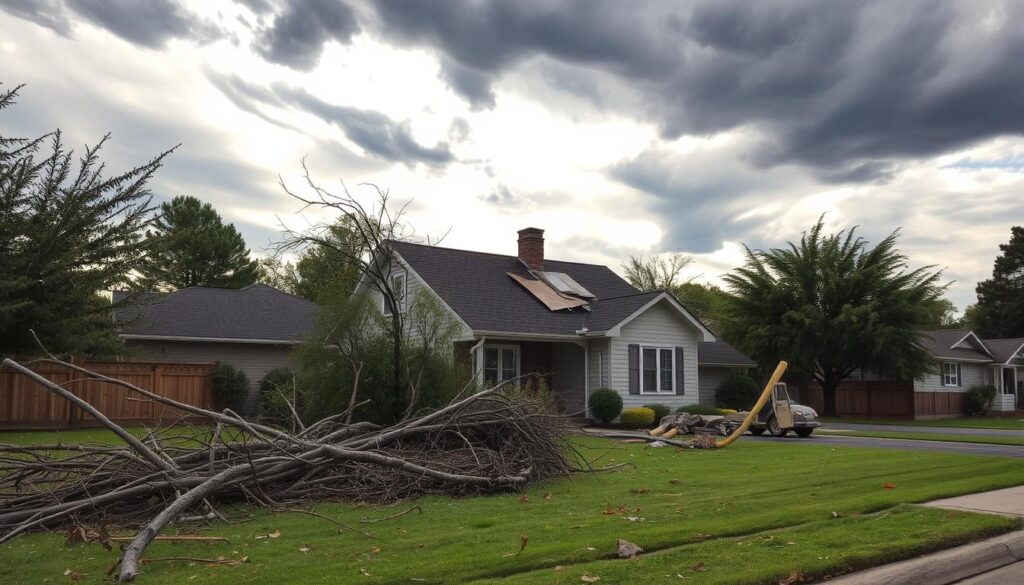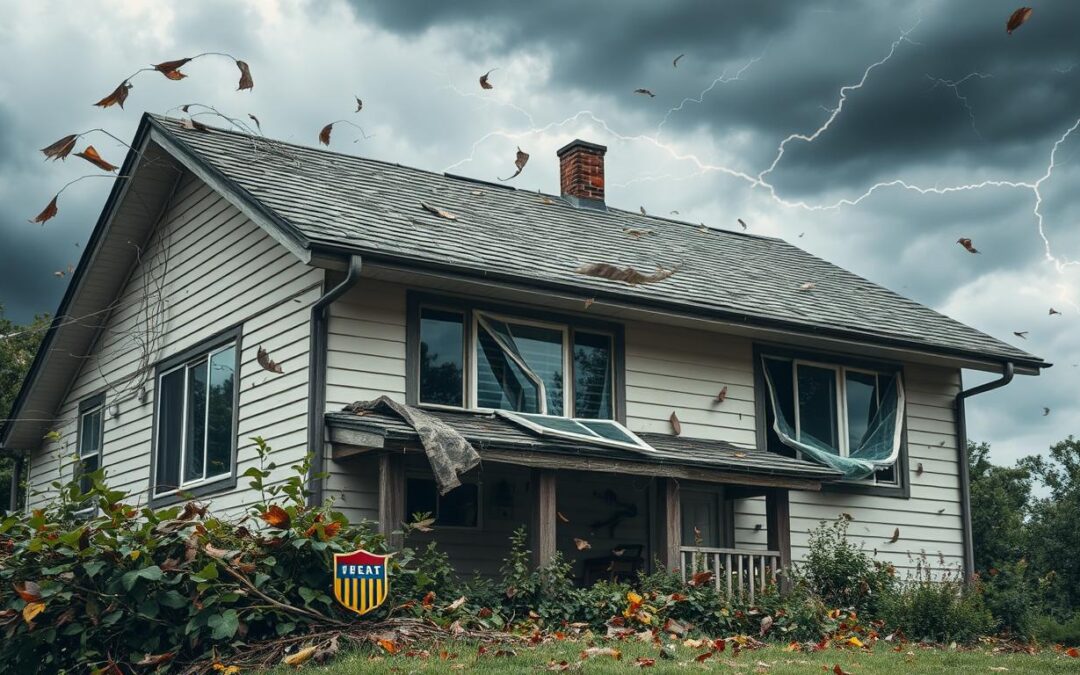Welcome to our guide on wind damage insurance coverage. Homeowners insurance can be confusing, especially for wind damage. It’s crucial to understand how it works, especially in areas with lots of wind and storms.
In this article, we’ll look at how homeowners insurance handles wind damage. Knowing what your insurance covers is key to avoid unexpected costs. Let’s get into the details to keep you informed and safe.
Understanding Wind Damage in Homeowners Insurance
It’s key to know what wind damage is and how it affects our homes. Wind damage happens when high-speed winds, like from tornadoes or hurricanes, damage our properties.

What Constitutes Wind Damage?
Wind damage can harm our homes in many ways. It includes:
- Roof Damage: Strong winds can cause missing shingles, leaks, and harm to the structure.
- Window Breakage: Wind can break glass and frames, especially if debris hits them.
- Structural Compromise: Winds can damage walls, foundations, or other key parts of our homes.
It’s important to know what wind damage your insurance covers. For more information, check out this link.
Common Types of Wind Damage to Homes
There are many types of wind damage homes can face. These depend on the area and how strong the winds are. Some common ones are:
- Tornado Damage: Tornadoes can severely damage structures, uproot trees, and move fences.
- Hurricane Impact: Hurricanes can remove roof tiles, break windows, and cause flooding.
- Thunderstorm Effects: Thunderstorms can damage the outside of homes and garden items with their sudden gusts.
Knowing about these types of damage helps us protect our homes better. It also shows why it’s crucial to understand our insurance coverage and make sure we’re well-protected.
Does Homeowners Insurance Cover Wind Damage?
Knowing if homeowners insurance covers wind damage is key for good wind damage protection. Most homeowners insurance policies do cover wind damage. But, the details in each policy can differ a lot.
Look for the wind damage coverage details in your policy. Policies usually cover damage from windstorms, hurricanes, or tornadoes. But, it’s important to check what’s included and what’s not.
It’s important to read your insurance agreement carefully. This will help you understand what’s covered. Here’s a quick look at what some policies offer:
| Provider | Wind Damage Protection | Wind Damage Coverage Details |
|---|---|---|
| Allstate | Included in standard policy | Covers windstorms and hurricanes; special hurricane deductibles may apply |
| State Farm | Included in standard policy | Covers windstorms, tornadoes, and hurricanes; regional endorsements may be required |
| Progressive | Included in standard policy | Covers most wind-related damages; verify deductibles and exclusions |
It’s wise to check your insurance policy provisions closely. Talk to your insurance provider if you’re unsure. Knowing your policy well ensures you have enough wind damage protection. It also helps you decide if you need more coverage.
Windstorm Coverage in Home Insurance Policies
Knowing about windstorm coverage in home insurance is key for homeowners. It helps protect their homes from severe weather. This part explains how it works, what’s not covered, and regional differences. It aims to help homeowners make smart choices.
How Windstorm Coverage Works
Windstorm coverage is part of standard home insurance. It helps pay for repairs or replacements due to high winds, tornadoes, and hurricanes. But, each policy is different. It’s vital to check your policy to know what’s covered.
Typical Exclusions and Limitations
Windstorm coverage is broad, but there are wind damage exclusions to know. These include damage to outdoor items like fences and pools. Also, flooding damage during a windstorm might not be covered. Some policies have limits on how much they pay out or require higher deductibles for wind claims.
Regional Considerations for Wind Coverage
Regional insurance requirements affect windstorm coverage. Coastal areas, like those hit by hurricanes, might have higher premiums or special coverage. States like Florida and Texas have strict rules for windstorm policies. Knowing these regional needs is crucial for protecting your home.
| Region | Specific Requirements |
|---|---|
| Florida | Mandatory windstorm coverage endorsements in high-risk zones. |
| Texas | Optional windstorm policies with separate deductibles. |
| California | Varied requirements; often reliant on statewide natural disaster policies. |
Making a Wind Damage Insurance Claim
Filing a wind damage claim involves understanding key steps and needed documents. Knowing how to navigate this process can save time and reduce stress. Let’s look at how to do it step by step.
Steps to File a Wind Damage Claim
- Assess and Document Damage: First, check the damage to your property and take clear photos.
- Review Your Policy: Get to know your insurance policy to see what’s covered.
- Contact Your Insurer: Tell your insurance company right away to start the claim process.
- Submit Required Documentation: Fill out claim forms and send photos and repair estimates.
- Temporary Repairs: Do any urgent repairs to stop more damage.
Knowing these steps can make filing insurance claims easier and prepare you for what’s needed.
What to Expect During the Claim Process
After you file your claim, an adjuster will check the damage. Here’s what happens next:
- Inspection: The adjuster will thoroughly check your property.
- Evaluation: They’ll figure out the repair cost and what your policy covers.
- Settlement Offer: You’ll get an offer for how much you’ll be paid back.
- Repairs: After you agree to the offer, you can start permanent repairs.
Knowing what to expect at each stage helps manage your expectations and plan better.
Common Challenges and How to Overcome Them
Dealing with claim challenges is common. Issues include:
- Disputes Over Damage Assessment: Get a public adjuster if you don’t agree with the insurer’s assessment.
- Claim Denials: Know why your claim was denied and gather more evidence to support it.
- Delayed Payments: Keep in touch regularly and be persistent with your insurer.
Using effective strategies can help overcome these challenges and make the claim process smoother.
Protecting Your Home from Wind Damage
Keeping our homes safe from wind damage needs both quick fixes and long-term plans. Preventive measures for wind damage include short-term actions and lasting improvements. By spending time and money on these steps, we can lower the risks a lot.
Reinforcing homes against wind is key. We can do this by using wind-resistant roofing, adding storm shutters, and making garage doors stronger. These steps help protect our homes from severe damage during strong winds.
Landscaping around our homes is also important. We should trim trees and shrubs to remove dead or weak branches. Also, securing outdoor furniture and items can stop them from becoming dangerous in a storm.
Also, mitigating wind damage risks can lower our homeowners insurance costs. Many insurers give discounts for homes with wind mitigation features. Installing hurricane straps, reinforcing roof-to-wall connections, and securing the house to its foundation can save money.
Knowing local building codes and following them is also vital. These codes help ensure our home improvements meet standards. This makes our homes safer and more solid.
By taking these steps, we make our homes safer for our families and help them last longer. Protecting our homes from wind damage not only keeps our property safe but also saves money on insurance and repairs. Starting these efforts now can greatly help protect our homes from future storms.
Protecting our homes from wind involves both quick and long-term actions. Every effort, from upgrading materials to securing outdoor items, helps make our homes more resistant to wind.
Conclusion
As we wrap up, it’s key to remember the main points about wind damage and insurance. Knowing your homeowners insurance policy well is crucial. It helps ensure you’re covered when a windstorm hits.
Learn what wind damage is and the types that can harm your home. Understanding your coverage, including any limits, helps you prepare better. This way, you avoid surprises when filing a claim.
Check your policy and look into wind coverage tips for your area. Knowing what’s covered and taking steps to protect your home is important. This knowledge makes filing claims easier and less stressful.Filing a water damage claim shows the value of clear documentation and knowing your insurance benefits.
Finally, being ready for windstorms is essential. By focusing on your policy details and protecting your home, you’ll have peace of mind. Being prepared is not just a good idea; it’s a must to protect your valuable assets.

